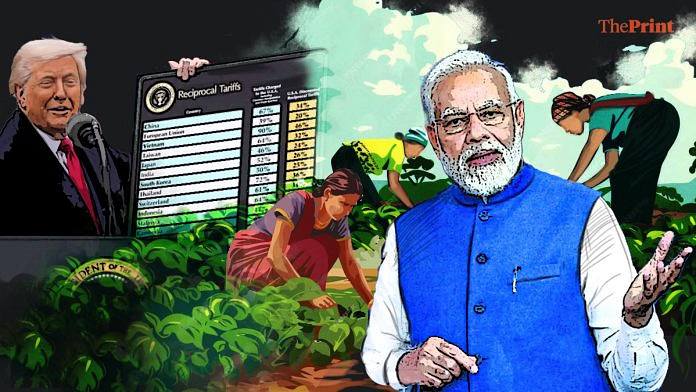
Kicking off the M.S. Swaminathan centenary commemorations, Prime Minister Narendra Modi vowed to protect the interest of the Indian farmer, fishing and dairying communities, whatever the risks or costs, and whatever price he might have to pay for it personally. The question: what is the price he and the country may have to pay?People of India value their sovereignty over any personal comfort or worldly needs. They will stoically absorb even short-term loss of jobs for national self-respect. Think of shrimp farmers, basmati and spices growers, carpet weavers, hosiery workers, and artisans mostly in Gujarat cutting diamonds, gems and fitting them into gold jewellery, all hit by 50 percent tariffs.
One more category, probably as numerous as all of the above, will also be hit: the farmer. India exports loads of basmati rice, spices, fruits and vegetables, packaged foods, tea and coffee to the US, adding up to more than $6 billion. These are not going to survive a 50 percent tariff. Our immediate neighbours will benefit. All of these among our most vulnerable and marginal economic communities will be paying the price for Trump’s madness, unless there is a reversal. What will then be the personal risk to the Prime Minister? He probably means the pressure the US brings upon his government may destabilise it. Or if economic distress rises as a result, it will help the Opposition build protests. He’s telegraphing to us, in code, the return of the evil foreign hand.
That he is one of our most politically and electorally astute leaders ever, we can have little argument with. So, you have to pay serious attention to what he’s saying. It is just that standing up to America is usually not a personal risk for a leader in India. Indira Gandhi did so with panache and benefited from it. Any suggestions of foreign pressure unites India behind their leader of the day. To that extent, there is no personal risk to Modi. Since he is sounding so defiant and in a risk-taking mood, however, we might point to a direction that will indeed entail political and even personal risk for him. If it works, and there is no reason why it shouldn’t, it would revolutionise Indian farming. It will not only finally enable him to double the farmer’s income in the next five years, but also make them globally competitive. What is it that he needs to achieve that revolution, and the personal risks it might involve?That’s why, the setting in which he was speaking last Wednesday becomes significant. Swaminathan, to whom this government awarded the Bharat Ratna, is widely acknowledged to be a parent of our Green Revolution and credited with ridding us of the national humiliation of living a ship-to-mouth existence. In the 1960s, Lyndon B. Johnson’s administration simply had to delay the next ship to make India suffer and squirm. Among his asks was that India reduce its population growth drastically. That era ended with the Green Revolution and food grain self-sufficiency by 1971-72.
American agronomist Norman Borlaug, had drawn widespread criticism and suspicion from the usual suspects. The activists and the Communists. At the release of the Swaminathan biography written by his niece Priyambada Jayakumar, key panellists noted that there was a widespread fear of the hybrids and the suspicion that any mechanisation will only benefit the rich farmers. That’s why the Swaminathan-led group of reformers set up the first field trials with small farmers. There is also the telling story of how difficult it was for Mrs Gandhi’s government to permit the import of 18,000 tonnes of hybrid seeds for demonstration, in 1966, valued at Rs 5 crore. Mrs Gandhi held her nerve. There were risks if the new seeds brought in some destructive pestilence, or if the experiment simply failed.
Mrs Gandhi was game and her reward was India getting freedom from hunger and humiliation. High risks equal high rewards. Wartime risks are an inevitability. The boldest leaders are those who choose risks in peacetime. That’s why an impetus, a push, is needed. In 1991, for Rao-Manmohan, it was the balance of payments crisis. From 1999 onwards, for Vajpayee, the post-Pokhran sanctions brought that gun to the head. In the past two decades, we haven’t faced a crisis of such dimensions. That, combined with the still high—though decelerating—growth rates over the past 25 years has bred complacency. It is characterized by that repeated boast of the fastest growing large economy, the fourth largest etc, etc. Better informed people, experts have been talking of dozens of sorely needed reforms in manufacturing, infrastructure, terms of trade, tariff reduction, etc. Each one is challenging, particularly in our governance system. Manish Sabharwal probably understates it by using the term regulatory cholesterol.
This system is actually worse, still atrophied. So, we can’t underestimate these challenges. It is just that none of them is of a magnitude that entails personal risk to the Prime Minister. Just as the earlier crises precipitated dramatic reforms in Indian industry, finance, competitiveness and technology, why not use this opportunity to launch a new generation of farm reforms. Truth to tell, Indian farming has generally trudged along as if in the second gear since the Green Revolution. That isn’t good enough for India. If we hadn’t been so lazy and afraid, Trump’s pressure on our agriculture wouldn’t have felt so severe.
The last really bold agricultural reform was the Vajpayee government allowing GM (Bt) cotton seeds in 2002, ignoring massive resistance from his Swadeshi base. He had already stretched Jai Jawan, Jai Kisan to Jai Vigyan after Pokhran-2. Now, he said, Bt will do to Bharat what IT did for India.You want to see what a farm revolution looks like? In the decade between 2002-03 and 2013-14, the cotton output rose from 13.6 million bales to 39.8 million bales, a neat 193 percent rise. The per hectare yield nearly doubled from 302kg to 566kg.
These figures are from the Indian Council for Research on International Economic Relations (ICRIER). From being a perennial cotton importer, India became a sizable exporter, topping $4 billion in 2011-12. It was the second-largest grower after China. The biggest beneficiary was the farmer from Gujarat, enjoying an eight percent growth over that decade.Today, India is back to importing, including about half a billion dollars worth from America. Our yields have fallen back from 566kg to 436kg per hectare. Compare it with China’s 1,945 (that’s no typo) and Brazil’s 1,839. The global average is 770kg. That is how badly we’ve collapsed.



